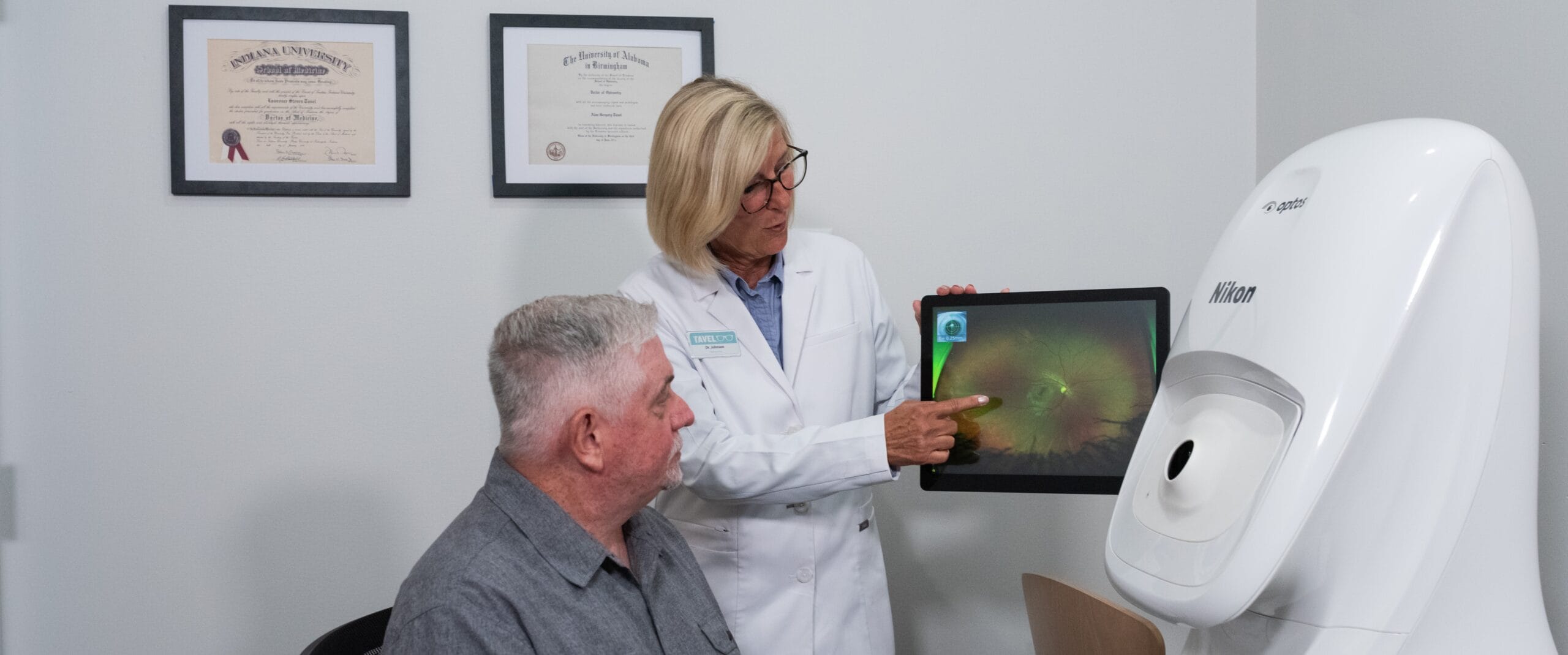

Eye Conditions We Treat
Our optometrists at Dr. Tavel have the expertise and technology needed to diagnose and treat a wide range of common eye problems and health conditions.
Have confidence knowing that Dr. Tavel is your trusted partner in your personal eyecare journey for wide variety for of eye problem and conditions. In addition, our insurance acceptance guarantee means you never have to sacrifice high-quality care for insurance coverage. Ready to schedule your appointment? Use our online scheduler to make prioritizing your eye health easier.
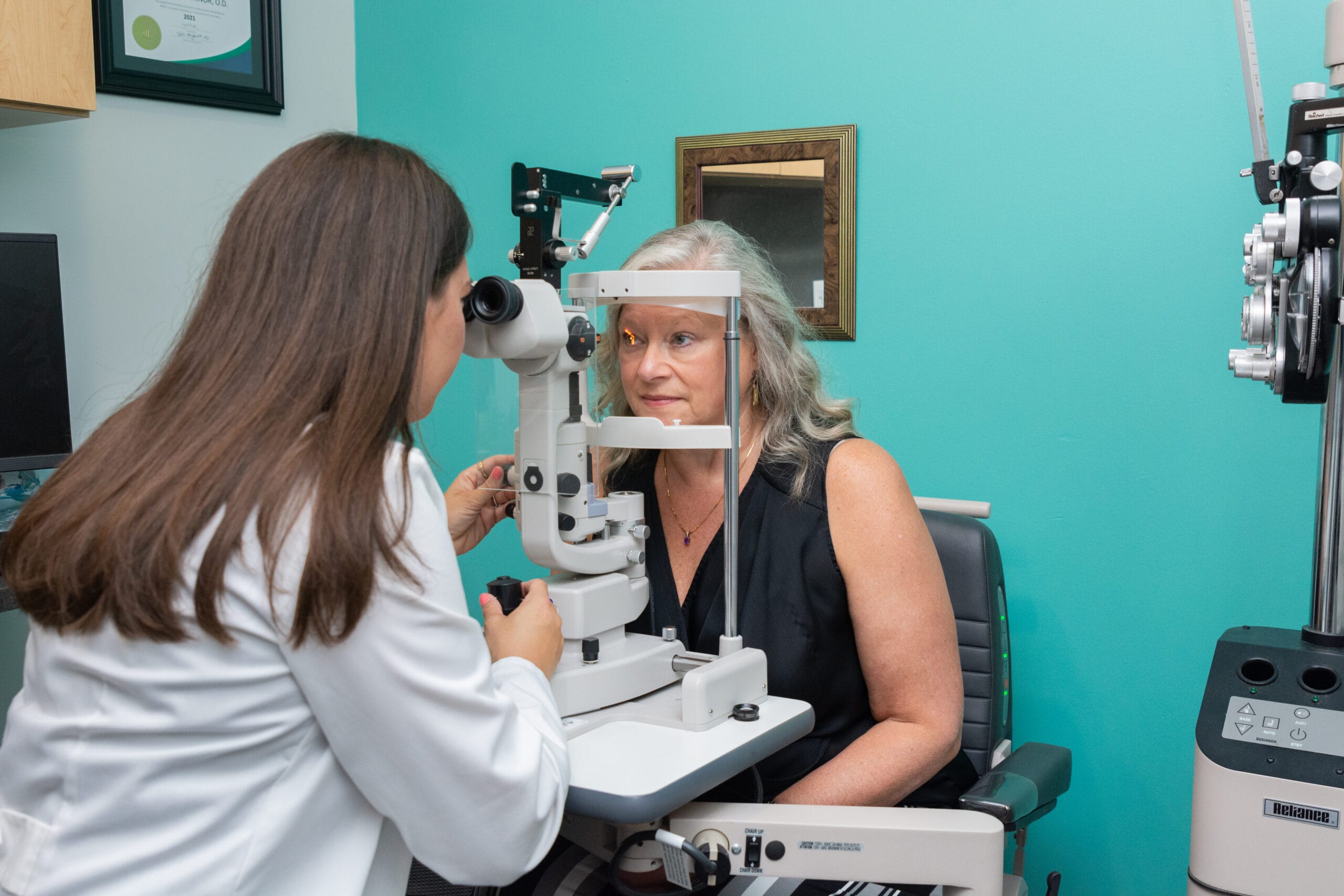
Diabetic Retinopathy
Diabetic retinopathy is an eye disease caused by diabetes that can lead to vision loss. Your eye doctor will monitor your condition, refer you to a retinal specialist if necessary, and coordinate with your primary care doctor to ensure comprehensive care.
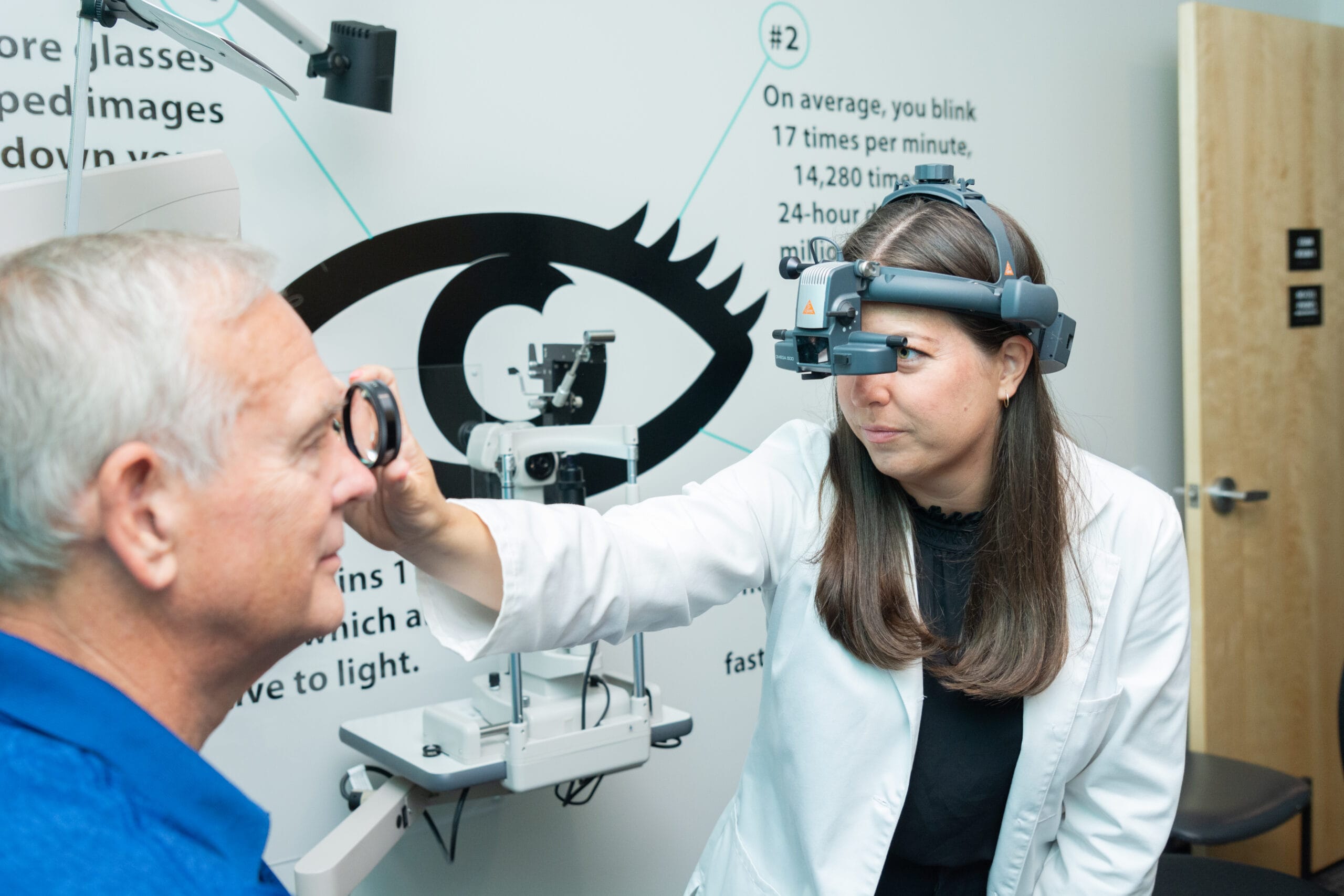
Cataracts
Cataracts develop when the eye’s lens clouds due to natural protein buildup over time, affecting vision clarity. Your eye doctor will diagnose and monitor your cataracts, referring you to a cataract surgeon when surgery is needed and providing comprehensive post-op care.
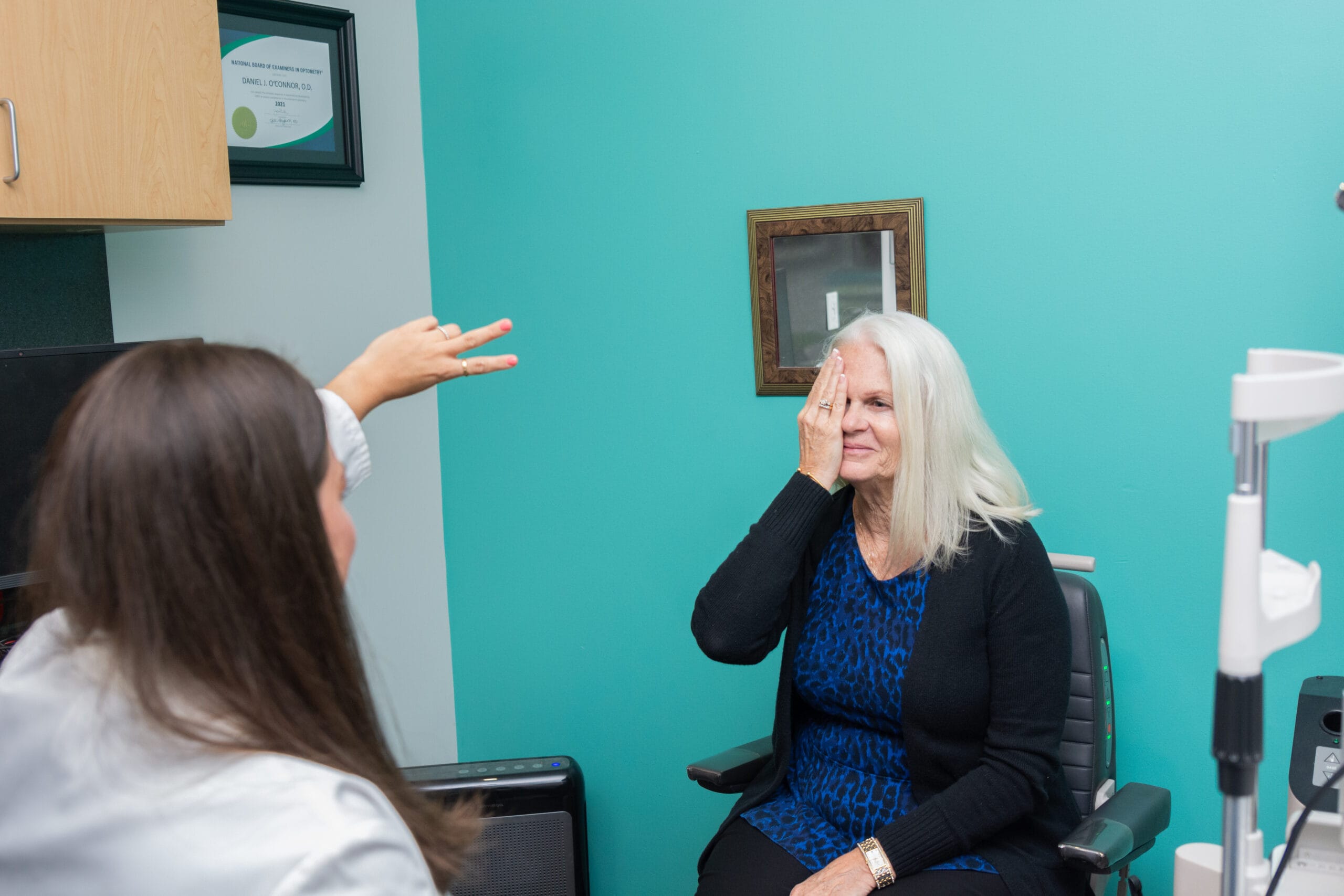
Macular Degeneration
Macular degeneration affects part of the retina, causing loss of central vision. Dr. Tavel will monitor your condition closely, especially for the progression of wet macular degeneration. If necessary, you’ll be referred to a retinal specialist for additional treatments, such as injections if needed.
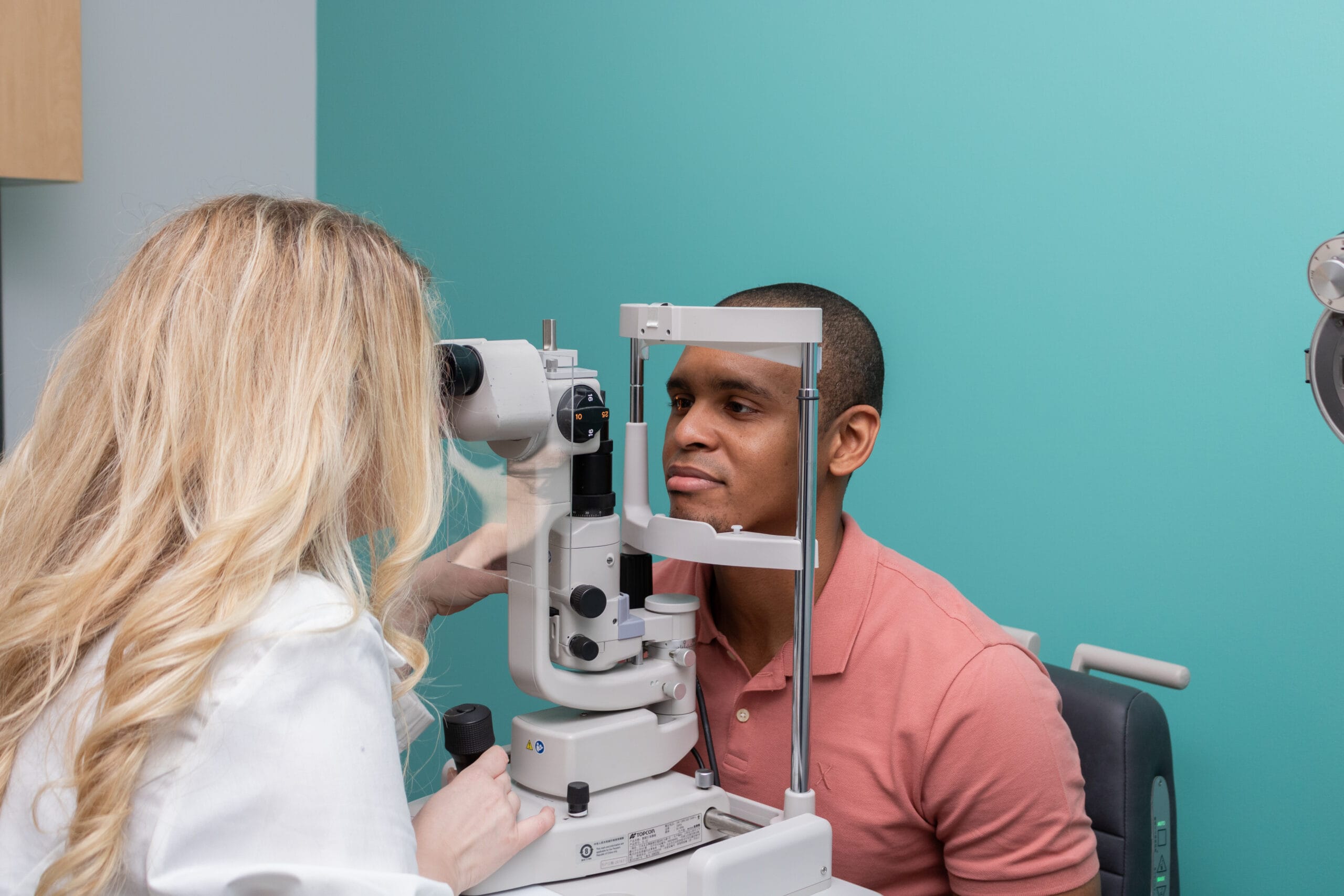
Glaucoma
Glaucoma is an eye disease that damages the optic nerve due to increased fluid pressure, and often shows no early symptoms. Your eye doctor will diagnose and manage your glaucoma by monitoring eye pressure, prescribing special eye drops, or referring you to a specialist if further treatment is needed.
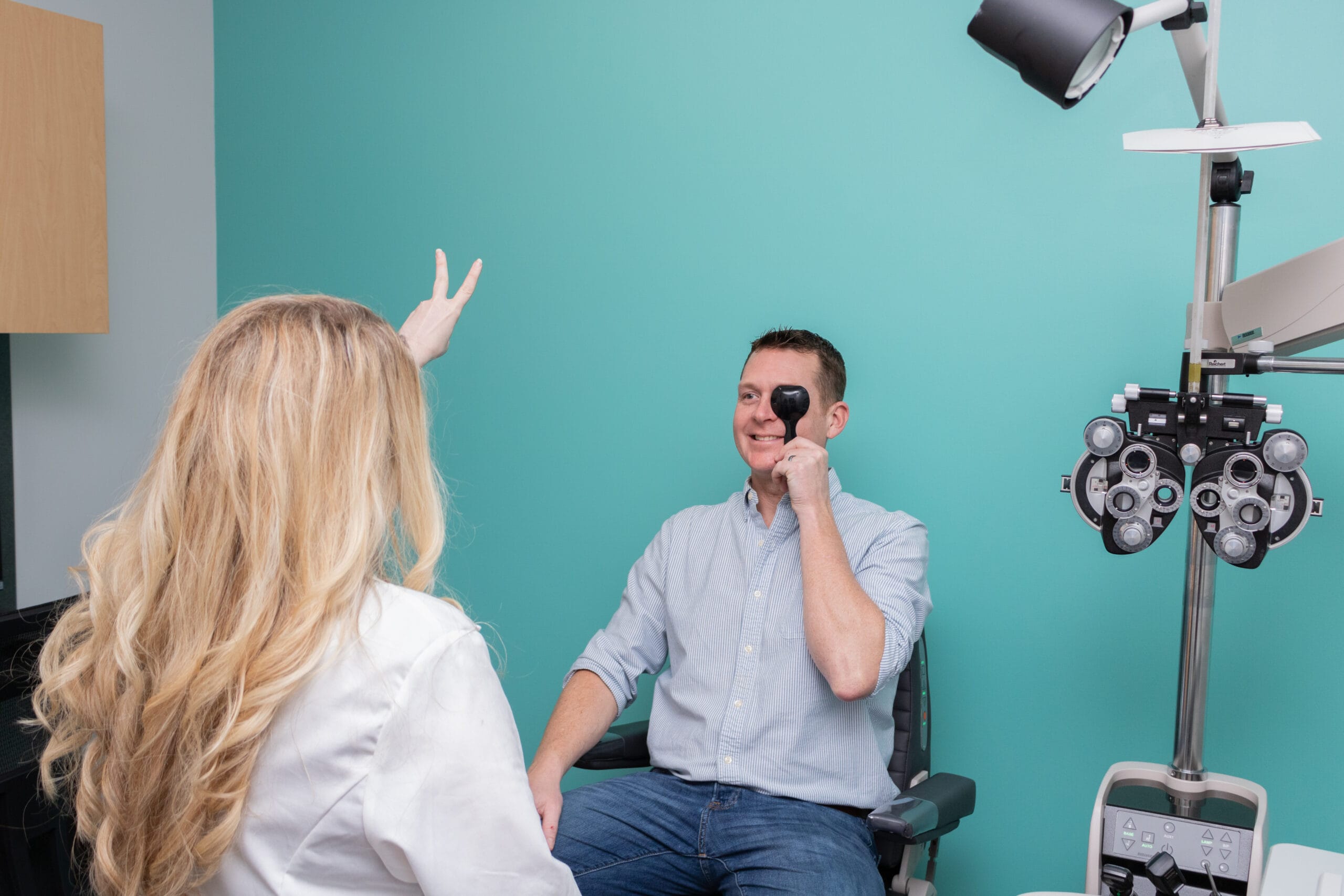
Eye Injuries & Infection
Our doctors are ready to deliver effective same-day care for urgent eye injuries and infection. Eye emergencies such as pain, foreign bodies, sudden vision loss, pink eye symptoms, and flashes of light are triaged by phone with your doctor to determine the urgency of the eye issue.
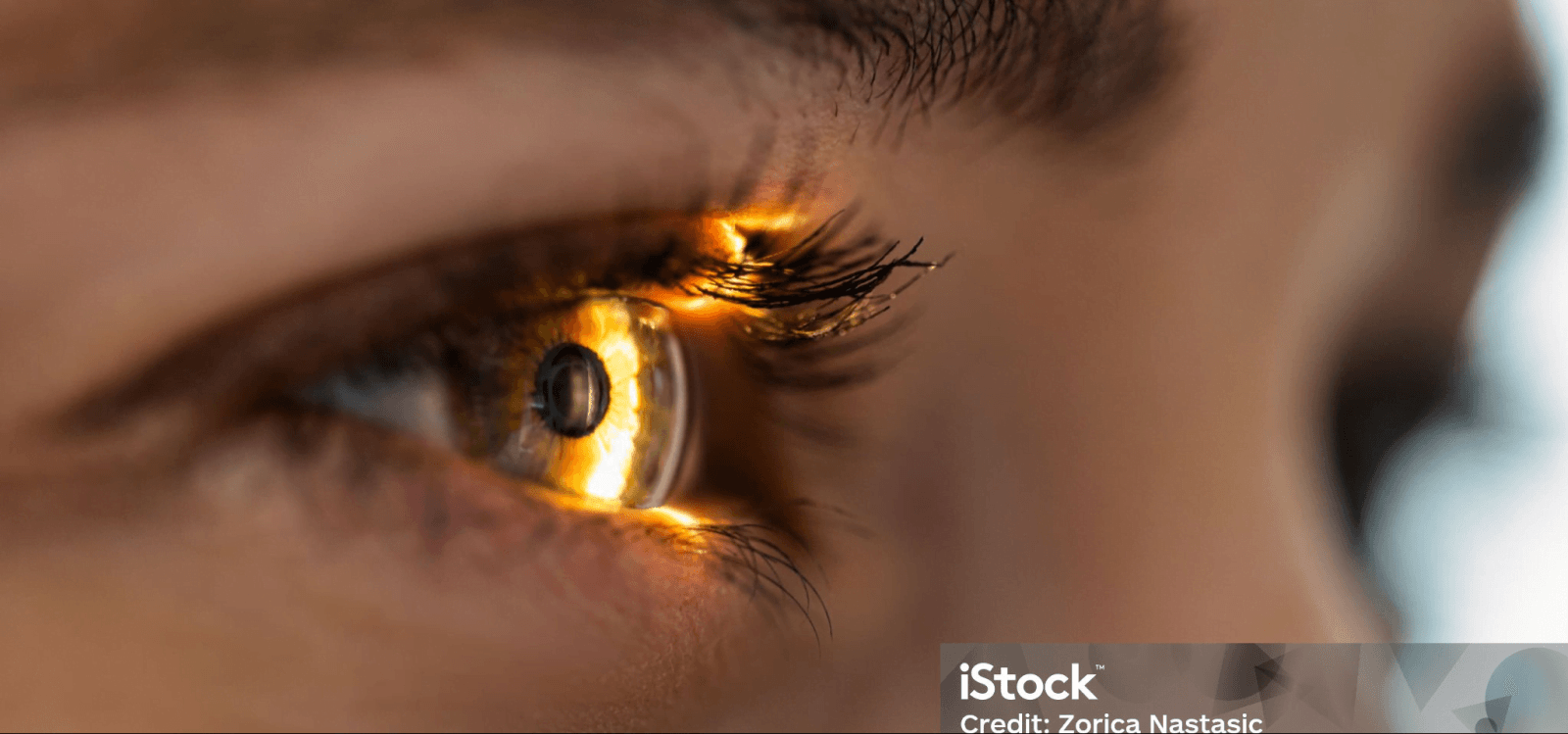
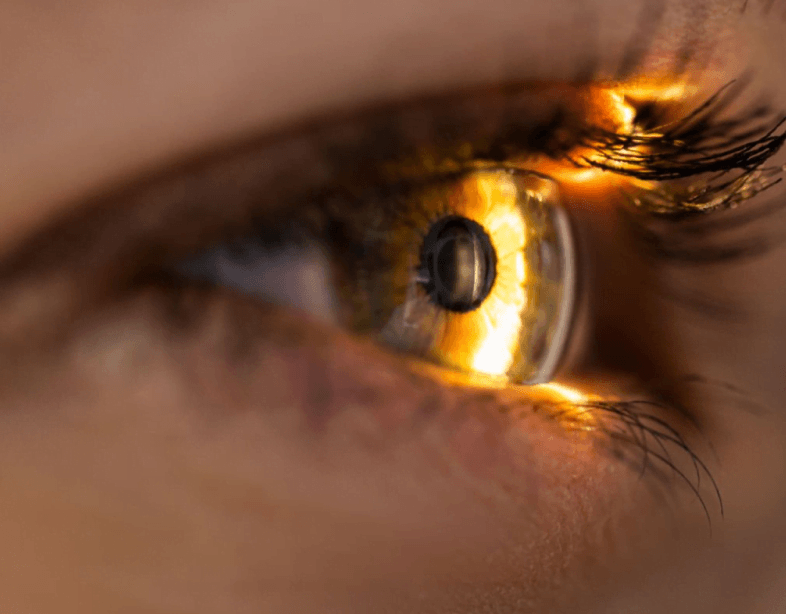
Browse All ConditionsWe Treat
Our doctors are well equipped to diagnose the following eye problems and personalize treatment that best meets your needs.
A
Astigmatism is a common refractive error that causes blurred vision. Blurry vision occurs when the cornea (the transparent surface of the eye) is abnormally curved (usually shaped like a football) due to light being unevenly distributed on the lens of the eye. The cornea is normally spherically shaped. This allows light to enter the eye more evenly, making it easier to see clearly.
Your eye doctor will prescribe glasses to correct your astigmatism. Depending on the amount of astigmatism they may also recommend certain lens materials or coating to optimize your lens and reduce distortions.
Anisometropia is where both eyes have very different prescriptions or vision quality, which leads the brain to suppress one image to avoid double vision. Anisometropia can cause amblyopia in young children.
In cases of anisometropia, your doctor may find you have a concurrent condition called Amblyopia which may require more treatment. Your doctor may also prescribe specialty lenses to help minimize the thickness differences of the lenses.
Amblyopia (also called lazy eye) is where abnormal vision development causes reduced vision in one or both eyes—often seen as one eye turning inward or outward. It usually develops before age 6 and early diagnosis increases the chance of a complete recovery.
Your eye doctor can treat and provide care and therapy for amblyopia. For children, this sometimes requires glasses and close monitoring of their vision as their eyes develop. It can also involve occlusion therapy with eye drops or a patch to help strengthen the poorer eye’s connection to the brain.
B
Blepharitis is a recurring eyelid inflammation in which the eyelids become red, itchy, and flake-like scales can develop on the base of the eyelashes.
Our eye doctors are trained to diagnose and treat blepharitis to improve lid comfort. They may prescribe a medication to the pharmacy or recommend some other over-the-counter treatment options depending on the severity.
C
A corneal ulcer (also known as keratitis) is an open sore on the cornea (the transparent surface of the eye). A corneal ulcer can result from an eye infection, severe dry eye or other eye disorders.
Our doctors can diagnose and treat corneal ulcers and provide resources on how to prevent future ulcers. Corneal ulcers can badly damage your vision and even cause blindness if they are not treated. Treatment generally involves prescription eye drops and frequent follow-up visits. If necessary, Dr. Tavel will refer you to a corneal specialist.
Corneal dystrophies are a group of rare genetic eye disorders involving the cornea (the transparent surface of the eye). Most corneal dystrophies affect both eyes. They progress slowly and typically run in families.
Dr. Tavel doctors can diagnose and manage corneal dystrophies or make an appropriate referral for more advanced treatment options depending on the severity. Some dystrophies can be managed by observation only while other involve lifestyle changes, medication, or even corneal surgery.
A corneal abrasion is a cut or scratch on the cornea (the transparent surface of the eye). Corneal abrasion symptoms include eye pain, light sensitivity and tearing with a possibility of infection.
Our eye doctors can diagnose and treat corneal abrasions. This sometimes involves prescription medication or the insertion and removal of a bandage contact lens to manage comfort.
Conjunctivitis (also called pink eye) is an inflammation and irritation of the conjunctiva, which is the membrane lining that covers the white part of your eye. Some cases of pink eye are extremely contagious and most often caused by a viral or bacterial infection but can also be caused by allergies.
Our Optometrists have the qualifications and expertise to diagnose, treat, and manage eye infections like conjunctivitis. We recommend all patients see an eye doctor for eye infections and see their primary care doctor or pediatrician only in cases when an appointment with an eye doctor cannot be made. Our optometrists can prescribe oral or topical prescription medications to treat your eye conditions.
Congenital hypertrophy of the retinal pigment epithelium (CHRPE) is a typically benign, pigmented spot composed of enlarged cells and is typically found on the inside, back surface of the eye. It can vary in size but doesn’t show any symptoms.
Your Dr. Tavel doctor will document and monitor your CHRPE. Often, they will take a baseline photo of the CHRPE for future comparison.
A choroidal nevus is commonly identified as a dark pigmented lesion found in the back of the eye. It is like a freckle or mole found on the skin. A choroidal nevus usually does not cause symptoms and is found during a routine eye exam. In some cases, one can occur under the center of the retina and cause blurred vision.
Your eye doctor will document and monitor your nevus. Often, they will take a baseline photo of the nevus for future comparison.
Cataracts occur when the lens (clear part of your eye that focuses light) clouds up from natural proteins that build up over time. Depending upon the size and location, they can interfere with normal vision.
Your eye doctor will diagnose your cataracts and let you know when they get to a level that requires surgery to remove them. Your doctor will refer you to a cataract surgeon and after the surgery handle any post-op care you may need.
D
Dry eye happens when your eyes don’t make enough tears to properly lubricate your eyes, or when your tears don’t work correctly. This can make your eyes feel irritated and uncomfortable, and in some cases, it can also cause vision problems.
Dry eye is a chronic complicated condition that may take your eye doctor several approaches to manage. At Dr. Tavel, your doctor may discuss over-the-counter options, prescription eye drops, and lifestyle changes. Often moderate-severe dry eye management requires follow-up visits. For more severe cases, we will refer you to a dry eye clinic or dry eye specialist.
Diabetic retinopathy is an eye disease caused by diabetes. Diabetes can damage blood vessels and develop abnormal new vessels which can cause vision loss. It’s crucial that people with diabetes get regular eye exams to prevent vision loss.
Diabetic retinopathy is a serious condition that should be monitored regularly by your eye doctor. Dr. Tavel can refer you to a retinal specialist and communicate with your primary care doctor or endocrinologist if further treatment is needed.
Dermatochalasis describes the presence of loose eyelid skin. It is often seen in middle-aged and elderly people. Although more dramatically seen in the upper eyelids, dermatochalasis can also affect lower eyelids.
Our doctors can diagnose and manage this condition. If your doctor feels eyelid surgery, blepharoplasty, is warranted and you are interested in that surgery, Dr. Tavel will make the referral for you to an oculoplastic specialist.
E
Eyelid conditions include any type of inflammation, infection, benign and malignant tumors, and structural problems that affect the eyelid.
Your eye doctor will evaluate your eyelids as part of your annual exam, if there are any concerning lesions that need a biopsy, Dr. Tavel will make a referral, contact your primary care doctor, or recommend a dermatology appointment.
Certain high risk prescription medications require additional testing to monitor for toxicity in your eye. Your eye doctor knows the standards of care to monitor them. Plaquenil (hydroxychloroquine) is the most common oral medication that requires annual monitoring and special testing by your eye doctor.
Floaters are tiny clumps of gel or cells inside the vitreous (clear gel that maintains the shape of the eye) that look like small specks, dots, circles, lines or cobwebs in your field of vision. Flashes can look like flashing lights or lightning streaks in your field of vision. Flashes happen when the vitreous rubs or pulls on your retina.
If you are experiencing flashes or floaters, your eye doctor will most likely dilate your eyes in order to thoroughly evaluate your retina. Some conditions that cause flashes can be monitored by Dr. Tavel. Others, like retinal tears or detachments, require immediate referral to a retinal specialist.
F
G
Glaucoma is an eye disease that damages the optic nerve. It usually happens when fluid builds up in the front part of your eye. That extra fluid increases the pressure in your eye, damaging the optic nerve.
Your eye doctor can diagnose, manage, and treat your glaucoma. This involves special testing to determine the progression of the disease. Treatment for glaucoma usually involves monitoring eye pressure and treatment with eye drops. If glaucoma progression cannot be slowed or maintained with eye drops alone, Dr. Tavel will refer to an ophthalmologist who specializes in glaucoma and glaucoma surgeries.
H
Ocular hypertension occurs when the pressure in your eyes is above the range considered normal. Hypertensive Retinopathy occurs when the retinal vessels get damaged due to elevated blood pressure.
Our eye doctors are trained to monitor vascular changes in the retinal vessels due to high blood pressure. If Hypertensive retinopathy occurs and requires additional treatment like laser or injections, then Dr. Tavel will refer you to a retinal specialist.
Hyperopia, or farsightedness, is a vision condition in which distant objects are usually seen more clearly than close ones.
Your eye doctor will prescribe eyeglasses or contacts to correct for the blur caused by hyperopia. Your doctor will work with you to fine-tune your prescription and will recommend the best lens choices for you to see your best.
Hyperopia, or farsightedness, is a vision condition in which distant objects are usually seen more clearly than close ones.
Your eye doctor will prescribe eyeglasses or contacts to correct for the blur caused by hyperopia. They will work with you to fine tune your prescription and will recommend the best lens choices for you to see your best.
Your eye doctor will do special testing to look for dendrites (findings on the eye’s surface) that are evidence of a flare-up of the virus. Oral and topical treatment is often prescribed. If it is Shingles, your doctor will also communicate with your primary care doctor if you wish.
Histoplasmosis is a disease that comes from inhaling airborne Histoplasma spores into your lungs. These spores can enter the air when people disturb soil when plowing fields, sweeping chicken coops, or digging holes. If you have histoplasmosis, the infection can move from the lungs into the eyes (Ocular histoplasmosis), leading to vision loss.
The Histoplasmosis virus is particularly common in Ohio-River valley and our eye doctors are well versed in monitoring it. Presumed ocular histoplasmosis rarely reactivates, but it is still important to have it monitored annually at by your doctor.
I
J
K
L
M
Nearsightedness, or myopia, is a vision condition in which people can see close objects clearly, but objects farther away appear blurred.
Your eye doctor will prescribe eyeglasses or contacts to correct the blur caused by myopia. Your doctor will work with you to fine-tune your prescription and will recommend lens choices for you to see your best. For young children with elevated levels of myopia, your doctor may suggest a referral to specialists to try to help slow the progression of myopia.
Myasthenia gravis (MG) is a chronic autoimmune disorder that affects the voluntary muscles of the body, especially those that control the eyes, mouth, throat and limbs.
Myasthenia Gravis is a condition your eye doctor can help in diagnosing. Usually, this involves teamwork with your primary care doctor, rheumatologist, or additional healthcare team. Eye findings and symptoms can help aid in this diagnosis. Conversely, if already diagnosed, Dr. Tavel can monitor ocular complications that can occur with this systemic disease.
Meibomian Gland Dysfunction (MGD) occurs when the glands in your eyelids are obstructed or clogged and aren’t creating the necessary oils that keep your eyes healthy and protected.
Your eye doctor will help you diagnose and treat Meibomian Gland Dysfunction (MGD). This may involve over-the-counter options or prescription medication.
Macular Degeneration is an eye disease affecting the macula (the center of the light-sensitive retina at the back of the eye), causing loss of central vision.
Macular degeneration will be monitored by your eye doctor. You may be seen more than annually to monitor for the progression of wet macular degeneration, including bleeding in the back of the eye. Dr. Tavel will refer you to a retinal specialist for additional treatment options including injections to stop bleeding if needed.
N
O
P
Ptosis is when the upper eyelid droops over the eye. The eyelid may droop a little, or so much that it covers the pupil, blocking vision.
Your eye doctor will be able to determine if you would benefit from eyelid surgery and will refer you to a specialist if needed.
Presbyopia is the gradual loss of your eyes’ ability to focus on nearby objects. This typically becomes more noticeable in the mid-40s and worsens until around age 65.
At Dr. Tavel, your doctor will prescribe bifocals or reading glasses to help correct your presbyopia. Your doctor will go over lens options such as progressive lens vs lined bifocals and recommend what would work best for your prescription and lifestyle. You can also talk with your Dr. Tavel doctor to see if you would be a good candidate for multifocal contacts or monovision as well.
Q
R
A torn retina (the light-sensitive layer of tissue at the back of the eyeball) occurs when the retina has a tear or a hole, making your vision blurry. A torn retina is a genuine issue, but often leads to a more serious condition called a detached retina. This occurs when the retina is lifted away from the back of the eye. A torn retina must be treated immediately to avoid further vision problems or blindness.
A torn or detached retina condition often warrants an immediate referral to a retinal specialist. Your eye doctor can diagnose a tear or detachment, determine the level of urgency, and know where to send you.
At Dr. Tavel, your doctor will examine your retina during a eye exam to determine and treat any retinal diseases diagnosed. There are too many to make a comprehensive list and many are congenital (born with them) or hereditary from gene mutations.
S
Strabismus, commonly known as crossed eyes, is a condition in which both eyes do not look at the same place at the same time. It usually occurs in people who have poor eye muscle control or are very farsighted. Strabismus usually develops in infants and young children, but older children and adults can also develop the condition.
Your eye doctor will be able to diagnose and often manage strabismus with eyeglasses. If vision therapy or surgery is needed, your doctor can refer you to the right specialist. Managing strabismus and monitoring for amblyopia (lazy eye) may require more frequent visits and specialty lenses.
T
Toxoplasmosis is an infection in the eye caused by a parasite and can cause blurred vision, mild eye pain, and lead to vision loss.
Our eye doctors will be able to diagnose evidence of any current or previous infection from toxoplasmosis and monitor it for any reactivation during a comprehensive eye exam.
Thyroid eye disease (TED) is an eye disorder caused by an autoimmune disorder. Symptoms include inflammation and damage to the tissues around the eye, including muscles, fatty tissue and connective tissue. TED is often related to Grave’s disease which affects the thyroid, eyes, and skin.
Knowing your history of thyroid conditions will help your eye doctor monitor complications that can arise from high or low thyroid activity. Treatment may include medications, lifestyle changes or surgery. Your optometrist will refer you to a specialist if needed.
U
V
W
X
Xanthelasma are yellow growths that appear on or near the eyelids. They can be flat or slightly raised. They form when deposits of cholesterol (lipid or fat) build up under the skin. Xanthelasma are not harmful, but they can be a sign of heart disease and should be monitored closely.
At Dr. Tavel, your eye doctor can diagnose this xanthelasma during a comprehensive eye exam. Appropriate communication with your primary doctor and recommendation for cholesterol monitoring will be made if needed.